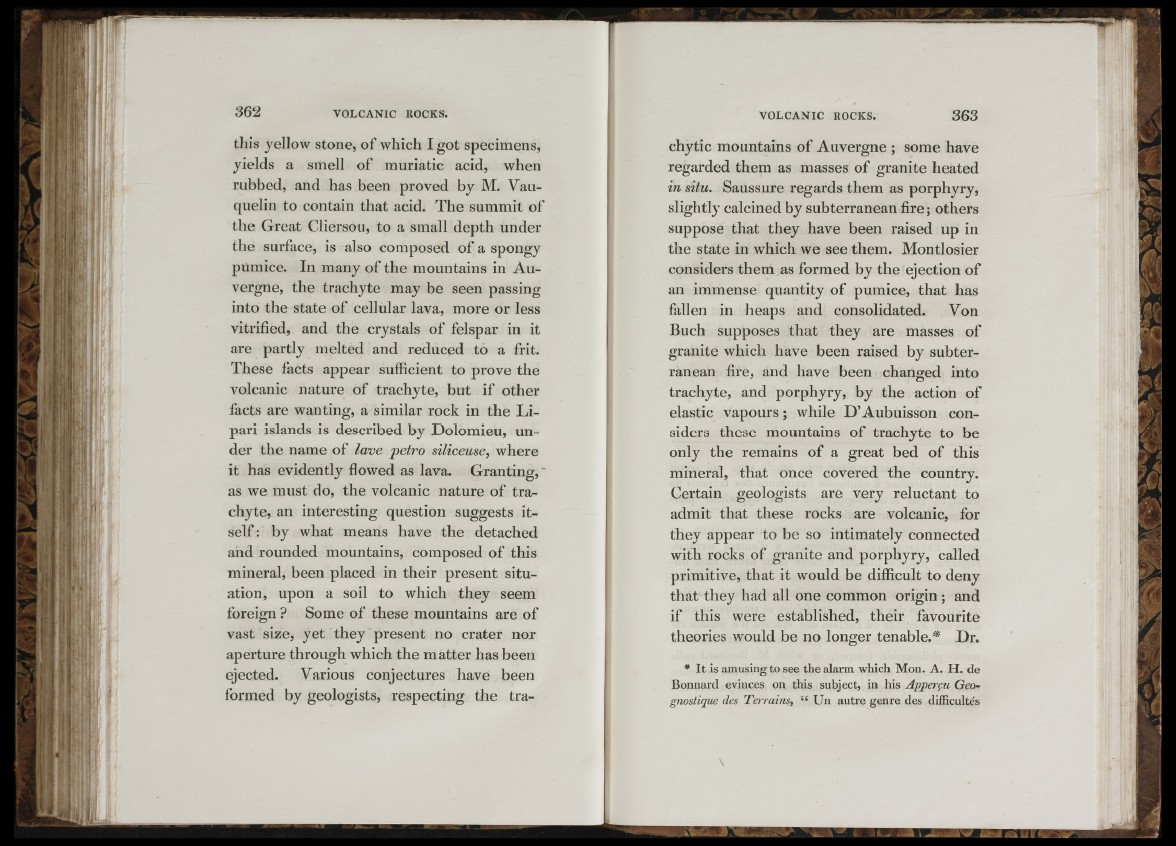
¡T
i ' t!-K Î
i J l l l i
iiUil! PI/I : * i! i i
'lyMiïifi' - i
~ m< h'î'jx
ipx-riiri ';
t e . ¿ 3 1 ' ^ X
Ph;p ;
l&ki
J' à;
a
h i :
ikkiflllJitlllli
1 ' T.a
Mi,:- : -L ^ ■- rB -, ■■■■„, f
æSiii I
• t *
' i: J,
362 VOLCANIC ROCKS.
this yellow stone, of which I got specimens,
yields a smell of muriatic acid, when
rubbed, and has been proved by M. Vau-
quelin to contain that acid. The summit of
the Great Cliersou, to a small depth under
the surface, is also composed of a spongy
pumice. In many of the mountains in Auvergne,
the trachyte may be seen passing
into the state of cellular lava, more or less
vitrified, and the crystals of felspar in it
are partly melted and reduced to a frit.
These facts appear sufficient to prove the
volcanic nature of trachyte, but if other
facts are wanting, a similar rock in the L ipari
islands is described by Dolomieu, under
the name of lave petro siliceuse, where
it has evidently flowed as lava. Granting,'
as we must do, the volcanic nature o f trachyte,
an interesting question suggests itself:
by what means have fhe detached
and rounded mountains, composed o f this
mineral, been placed in their present situation,
upon a soil to which they seem
foreign ? Some of these mountains are of
vast size, yet they present no crater nor
aperture through which the matter has been
ejected. Various conjectures have been
formed by geologists, respecting the tra-
VOLCANIC ROCKS.
chytic mountains of Auvergne ; some have
regarded them as masses of granite heated
in situ. Saussure regards them as porphyry,
slightly calcined by subterranean fire; others
suppose that they have been raised up in
the state in which we see them. Montlosier
considers them as formed by the ejection of
an immense quantity of pumice, that has
fallen in heaps and consolidated. Von
Buch supposes th a t they are masses of
granite which have been raised by subterranean
fire, and have been changed into
trachyte, and porphyry, by the action of
elastic vapours ; while D’Aubuisson considers
these mountains of trachyte to be
only the remains of a great bed o f this
mineral, that once covered the country.
Certain geologists are very reluctant to
admit that these rocks are volcanic, for
they appear to be so intimately connected
with rocks of granite and porphyry, called
primitive, that it would be difficult to deny
that they had all one common origin ; and
if this were established, their favourite
theories would be no longer tenable.* Dr.
* It is amusing to see the alarm which Mon. A. H. de
Bonnard evinces on this subject, in his Apperçu Geo-
gnostique des Terrains, “ Un autre genre des difficultés